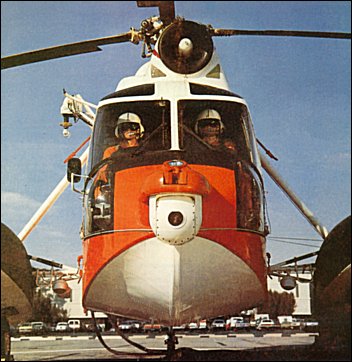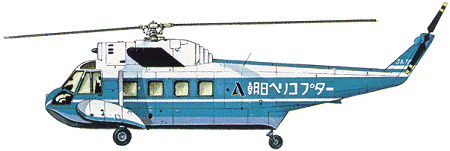
| Sikorsky S-62 / HH-52 1958 |  |
 |

| Sikorsky S-62 / HH-52 1958 |  |
 |
|
The Sikorsky S-62 was the first turbine-powered helicopter to be granted a type approval certificate by the U.S. Federal Aviation Agency, and was also the first type to pass the new stringent regulations introduced by the FAA to govern the operation of commercial passenger-carrying helicopters. In meeting these requirements it was undoubtedly aided by the fact that its design, drawn up in 1957-58, was based on using identical main and tail rotors and transmission systems, and other dynamic and mechanical features, of the thoroughly proven piston-engined S-55. The fuselage was entirely new, being designed for fully amphibious operation with a flying-boat hull and main undercarriage wheels semi-retractable within the two outrigged stabilising floats. Power was provided by a single General Electric shaft turbine engine, mounted centrally above the main cabin and accommodation provided for a 2-man flight crew and 10 airline passengers or 12 troops. Two S-62 prototypes were completed, with 1050shp T58-GE-6 engines derated to 670shp. The maiden flight on 22 May 1958, and subsequent world-wide demonstration flights, were made by N880, while N972 carried out trials for the FAA type certificate which was awarded on 30 June 1960; and a few days later the first production machine, designated S-62A, was delivered to a commercial customer. Later S-62A's have CT58-100 or -110 engines of 1250 (derated to 730) shp. In February 1962, after service trials with a modified S-62A, the U.S. Navy ordered four of these aircraft as HU2S-1G's for the U.S. Coast Guard. Subsequent naval orders for the HH-52A, as this version is now known, had raised the total to eighty-four by mid-1968 and it has been in use since early 1963. The HH-52A has the T58-GE-8 engine, military version of the CT58-110, and automatic stabilisation equipment. Additional features for coastal search and rescue work include a fold-down rescue platform and boat-towing gear. A rescue hoist can be mounted above the starboard cabin door to lift a maximum load of 272kg, or the S-62A can lift a 1361kg slung load by means of an under-fuselage hook. Two other S-62 variants have also been produced. The S-62B is essentially similar to the A model, but employs the rotor system of the Sikorsky S-58 with the main blades shortened by 0.33m. The S-62C is the equivalent of the HH-52A for commercial and foreign military customers. Apart from the U.S. Coast Guard, which remains the largest user of the type, the biggest single operator of S-62's is Petroleum Helicopters Inc, which has a fleet of six for work in support of offshore oil-drilling operations in the Gulf of Mexico. Of the forty-six S-62 type helicopters ordered, up to summer 1968, other than those of the USCG, nearly half were for customers in Japan, where Mitsubishi hold the licence. K.Munson "Helicopters And Other Rotorcraft Since 1907", 1968  The amphibious Sikorsky S-62 was derived from the piston-engined S-55 and used that helicopter's main and tail rotor system and other components mounted in a new sealed hull. The prototype S-62 flew on 22 May 1958 and was followed by the S-62A production version which, powered by a single General Electric CT58-110-1 turboshaft engine, provided accommodation for up to 11 passengers. One S-62B was built with an S-58 main rotor system. The S-62C was chosen by the US Coast Guard as a replacement for the HH-34 rescue helicopter and initial deliveries, under the designation HH-52A and named Seaguard, were made in January 1963. This version powered by a 932kW CT58-GE-8 engine was replaced by the HH-3 Pelican. The S-62 was also exported to Japan. By mid-1993, no military, and only a very small number of civilian, S-62s remain in use. D.Donald "The Complete Encyclopedia of World Aircraft", 1997
- HH-52s based at Houston, Texas, frequently practised recovery of the NASA Apollo astronauts. - First flight of the Sikorsky S-62 took place on 22 May 1958. - A small number of Seaguards were put on display in museums after retirement. - Nine examples were built under licence for service with Japanese Maritime Self- Defence Force (JMSDF). - One US Coast Guard machine was used in the film Airport '77. - A civilian S-62B model was built, but it was not popular on the civil market.
| ||||||||||||||||||||||||||||

|
|
 |